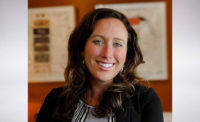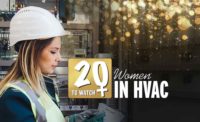Name/Title/Company: Kristen Banas, associate principal, HVAC, BR+A Consulting Engineers
Age: 42
Educational Experience: Bachelor’s degrees in mechanical engineering and business administration and management from Iowa State University
Professional Credentials/Accreditations: Professional engineer (P.E.) in Iowa
Organizational Affiliations/Achievements/Awards: ASHRAE and Society of Women Engineers (SWE)
What does your day-to-day job entail?
One of the reasons I love this job is my day-to-day responsibilities change every day. Mostly, I’m attending meetings (typically virtually), responding to or redirecting emails, and lending my ear and guidance to those with questions or concerns.
What caused you to/when did you fall in love with engineering?
I didn’t always think I wanted to be an engineer. I started college pursuing an engineering degree but contemplated leaving for a different degree. I was fortunate to attend Iowa State University (go Cyclones) and found my type of engineering in the school’s ME 442: Heating and Air Conditioning Design class.
What has been the most rewarding/proudest aspect of your engineering career?
The most rewarding aspect of my engineering career is helping owners achieve their visions, specifically with carbon reduction strategies. The proudest aspect is seeing the buildings I’ve helped design (typically hospitals) open and serve the public.
What challenges do women face in this profession? Can you give a personal example? Why aren’t there more women in engineering? How can we increase the number of women in engineering?
Women face a lot of challenges in this profession. The unfortunate part is this isn’t the only profession or realm where women encounter such issues. One personal, but simplified, example is being held to a higher standard to achieve a promotion than a male co-worker.
There is no simple answer when considering why there aren’t more women in the engineering profession. For reference, we must consider how the American society treats the female population in general, and how little girls in America are marketed to and taught to be. There’s a leak in the pipeline, meaning we get women into these degrees but then companies don’t work to retain them and they drop out (leaky pipeline).
There are plenty of STEM and other programs out there working to encourage girls and young women to pursue engineering. In my mind, one of the best ways to increase the number of women in engineering is by fixing companies’ leaky pipelines and showing (by action) they are willing to support women in engineering. This includes educating men and placing the burden on them to learn and grow in their support for all — and this must expand beyond gender.
How many years have you been active in the engineering sector? What’s changed the most in that time? What’s changed the least?
My whole professional career has been in engineering, so about 18 years. One of the things that’s changed has been the innovation/products, like adiabatic humidification (especially for health care). The ethics and responsibilities we have as engineers have changed the least.
You served as project manager on BR+A’s largest health care job to date. Introduce us to this project.
Ohio State University’s Wexner Medical Center (OSUWMC) New Inpatient Hospital was one of a few planned projects coined “time and change” for OSUWMC. The building is 1.9 million square feet and connects into the university’s existing James Cancer Hospital and Solove Research Institute (which BR+A also did engineering design for). Standing 27-plus floors tall , the building makes a statement. There are approximately 800 private patient rooms along with two levels of operating rooms, an emergency department, imaging, multiple kitchens, and a large open lobby that connects to the James Cancer Center’s lobby. Some pretty cool design was achieved, including triple-stacked air-handling units (AHUs) and a 99-foot prefab pipe riser (26,000 pounds and 1,500 linear feet of pipe).
You’ve served as membership chair and recording secretary for the SWE. Tell us about this group and the influence it’s had on your career.
SWE is a wonderful group, and I regret not joining while in college. I joined after starting my career. SWE has provided irreplaceable opportunities to grow and meet phenomenal women.
I served as membership chair and recording secretary for the Chicago section. It was an interesting role, considering how everyone is trying to figure out how to encourage women engineers to join and participate in the industry. This is especially true, considering associations are competing for women’s time against other organizations, including their discipline-specific organizations, and life. Membership chair definitely required being creative when encouraging participation. We started a book club, mostly nonfiction. Through this club, I read “The Confidence Code” which had a great influence on me personally and professionally.
Currently I participate in an affinity group for engineering moms. This group has supported me so much and helped me be a working, engineering mom.
What drives/motivates you every day?
This may sound funny or contrite but obligation. Knowing that others count on me drives and motivates me.
What remains on your engineering bucket list — what do you aspire to do that you haven’t accomplished yet?
I hope to earn the ASHRAE Healthcare Facility Design Professional (HFDP) certification and design a central energy/utility plant.
What’s one thing no one knows about you?
I’m not sure what I can put here because I am definitely an over-sharer, so most people know a lot about me. I would like to go hang gliding to round out my air-type experiences (hot air balloon ride, parasailing, sky diving, and flying).
List any mentors who’ve helped you succeed and describe precisely how they’ve shaped your success.
There’s been a whole host, but a handful I would like to highlight (in no particular order) are:
- Mary Ellen and Ed Banas (my parents) for exposing me to engineering; raising me; and, most of all, supporting me (especially now as a solo-by-choice mom);
- Mike Benjamin for teaching me about business development, helping me interview for projects, showing me how to manage project fees, and demonstrating how to think in a different way;
- Britt Ellis for being an ocean of knowledge;
- Grant Anderson and JP Marjollet for teaching me all the time about their respective disciplines (plumbing/medical, gas/fire protection, and electrical/fire alarm) to help me become a better project manager. Also, as principals, for teaching me more about running a company;
- Craig Webster for being a sounding board and giving such great advice;
- Jeff Trieber for teaching me about business development and navigating personnel issues;
- Brian Monahan for always having a positive word;
- Ashlie Kosar for becoming such a wonderful friend. I love how we push and support each other.
- Brooke Kelly for being one of the best bosses I’ve ever had. I still use her as a sounding board; and
- Will Etheridge for always being my coach.
What advice do you have for prospective female engineers considering entering the field?
It would be advice I found when reading “The Confidence Code” by Claire Shipman and Katty Kay. Two stories they told were eye-opening.
The first centered on a female manager who found herself favoring a male report over a female report and decided to look into why. For her, the male report would stop by her office to talk, updating her on what he was doing or had accomplished, while the female report just did her work and rarely stopped in. This instilled a need to communicate with my leaders more often, sharing what I’m doing and not being afraid to toot my own horn about my accomplishments and not just assume they are watching or aware.
The second story focused on female basketball players and how not moving past their failures hindered their confidence. I am still working on this trait.





